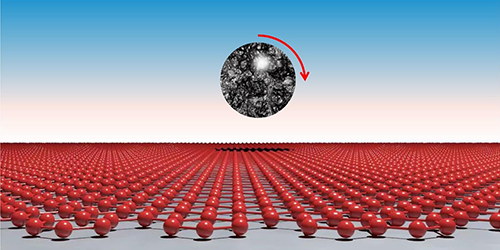Friction That Speeds Up an Object’s Motion
A classical object experiences friction only when it touches another object. A quantum one can experience a related force without contacting anything. That force, known as quantum friction, arises from interactions of the object with vacuum fluctuations, electromagnetic waves that pop in and out of existence. Now Lixin Ge of Xinyang Normal University in China proposes a new vacuum-fluctuation-induced force, negative vacuum friction, that acts in the same direction as the object moves, causing it to move faster [1]. Ge says that negative vacuum friction could offer a new approach to rapidly rotate nanoparticles, a technique potentially useful in precision measurements.
Ge considers a rotating nanometer-diameter sphere located near a graphene-coated substrate. Vacuum fluctuations interact with the rotating sphere and subsequently emit terahertz electromagnetic radiation. This radiation causes quasiparticles to form and flow on the substrate’s surface. These quasiparticles increase the magnitude of the electromagnetic interactions between the sphere and substrate, mediated via the vacuum fluctuations.
On most substrates, these quasiparticles will gradually slow down. But Ge predicts that on a graphene-coated system, the terahertz induced quasiparticles will accelerate as they propagate if the surface is illuminated with light. This acceleration induces the substrate to recoil in the opposite direction to the quasiparticle flow. According to Newton’s third law, the nanosphere must experience a force equal in magnitude but opposite in direction to the force the substrate experiences. This force pushes in the same direction as the sphere’s rotation—it is this force that that Ge calls negative vacuum friction.
–Sophia Chen
Sophia Chen is a freelance science writer based in Columbus, Ohio.
References
- L. Ge, “Negative vacuum friction in terahertz gain systems,” Phys. Rev. B 108, 045406 (2023).




